Cheaters Guide For Buying Vintage
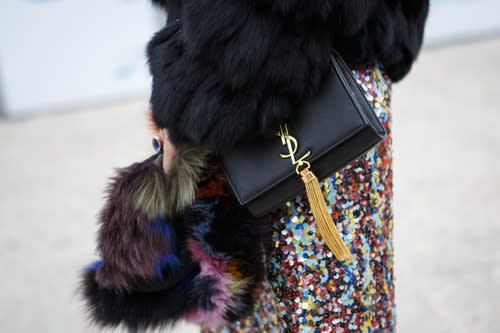
For the fashion conscious amongst us, shopping for vintage has become one of our favorite past times.
It’s all about the thrill of the hunt, browsing through rail after rail of weird and wonderful clothing - almost digging your way through the rags to unearth a buried hidden treasure.
But walking into a vintage shop can be an over-whelming experience especially for first time buyers who aren’t sure what to look for - so what is worth nabbing and what is simply pre-owned?
Written by Charlotte Goodayle, The Goodowl
Why Buy Vintage vs New
Before the days of mass production clothes and accessories where made by hand, which is where the quality lies - ahem couture anyone? Generally, the older the piece the higher attention to detail.
The fact that you can still buy pieces that look as good as the day they where made shows the quality. Not to mention, with vintage your unlikely to spot another person wearing the same outfit as you - no more awkward outfit clashes!
Difference between Vintage, Antique, Retro and Pre-Owned
Antique is anything over 100 years old. Vintage is over 20 years old and Retro simply means anything that looks out of style for the current time period, this could mean clothes from the late 90s - not yet vintage but still not considered ‘modern’.
Pre-owned is well you guessed it, simply that, pre-owned. This is usually what you find in charity shops. Anything that someone has recently bought and decided to gift away.
How do you know its vintage?
A few things to keep in mind when browsing. If a garment was manufactured before the mid-60s it will have metal zippers and side-snap closures.
A few interesting things to keep in mind: Signs that a garment was manufactured before the mid-’60s are metal zippers, side-snap closures and pinked edges.
Also, check the label, does it just have the company logo on? Or is there a full list of the materials used and washing instructions? If its the latter then chances are the piece was made after 1960. Care instructions were only added in the early 70s.
How To Shop Vintage
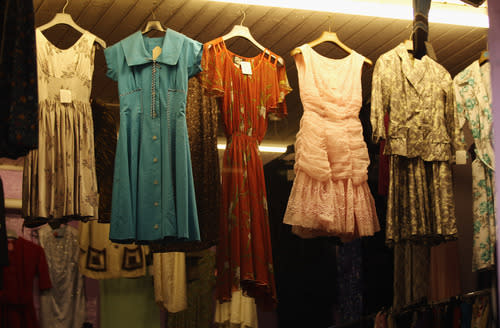
Try before you buy
It’s no good just picking up it up. If there’s something about it you like - it could be the fabric or the print - go try it on.
Vintage clothes weren’t designed to look good on hangers unlike todays massed produced pieces, so even if it looks frumpy on the rails, try it on you could be surprised.
Sizing
The best advice is just to completely ignore the label. Modern sizing is completely different to the sizing of yesteryear. Again like the above paragraph, just go try it on. Things can always be altered to fit later.
Don’t Bulk By
If your new to shopping vintage it’s easy to get carried away, you buy one piece and before you know it you’ve walked out with bags and bags of clothes you’ll never wear.
Shop with a garment in mind. How about a coat? You can mix it with your other high-street pieces, try a 70s suede sheepskin. It’s a timeless quality piece which always comes in season.
Things To Check
Always Check The Armpits
It sounds kind of gross but it’s the number one thing to look out for. Before the days of antiperspirant, sweat had a bad habit of ruining clothes and leaving behind frail and stained armpits, eww.
Look At The Fastenings
Give the garment a good once over, are all the buttons there? Are the zips working properly? This may sound minor and these things can easily and cheaply be replaced but you may be able to get a small discount in the store to cover the cost of the repairs.
Check The Seams
These garments have stood the testament of time, but who knows just how much wear and tear they have endured. Quickly have a look over the seams give them a gentle tug and see if they are holding well. The last thing you want to do is fork out some cash to the discover it falls apart after one wear.
Feel the fabric
A crucial thing to check is the quality of the fabric, has it still got life in it? Or will it remain just a trophy piece.
Leather and suede can become brittle if they’re not cared for, if it looks like its cracking, pulling or falling apart its probably best to leave it be.
What You Should Invest In
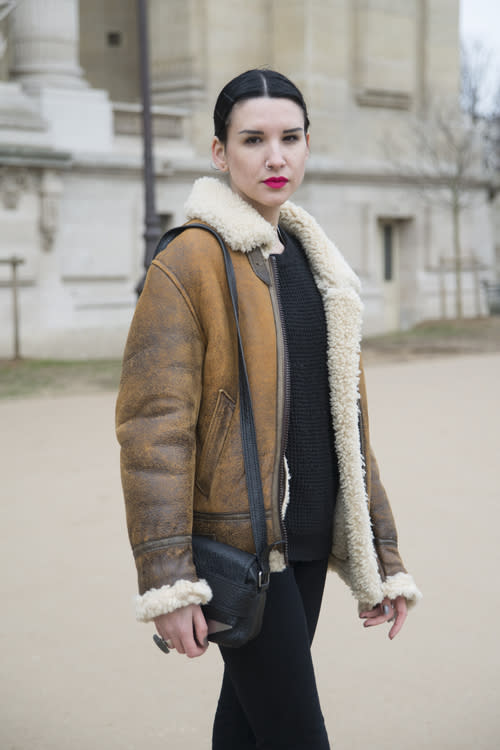
The Material
Natural fabrics will always be more valuable because of the resources required for them, but these fabrics are likely to age more - so its crucial to check them over. A good-quality knit is likely to age best due to the weave, which makes it excellent at holding its colour.
But also it’s worth remembering each different fabric has a history. Synthetic doesn’t necessarily mean its not valuable; rayon was the low cost super-fabric of the 40s and 50s.
The Label
Iconic labels will always be worth investing in.
Pre-war look out for Dior and Chanel’s sharp tailored suits. Post-war grab Dior’s ‘new look’, Hardy Amies tailoring and Balenciaga’s clean lines from the 1950s.
Keep an eye out for Mary Quant’s bold patterns and Ossie Clarks sought after designs from the 1960s.
Halston’s and Saint Laurent’s work from the 1970s, are also pieces to invest in and are the fashionistas brands of choice for the current 70s revival trend.
And if your really lucky and you come across a 20th-century Poiret orient inspired piece, definitely make the investment.
But its also important to remember. don’t be put of a great piece if there isn’t a designer label attached to it. Remember the quality was a lot better so they will generally still be worth the money.
Avoid
Stay away from the cheap and tacky polyesters of the 80s, those flame hazards should remain in the past.
How To Care For It & Repairs
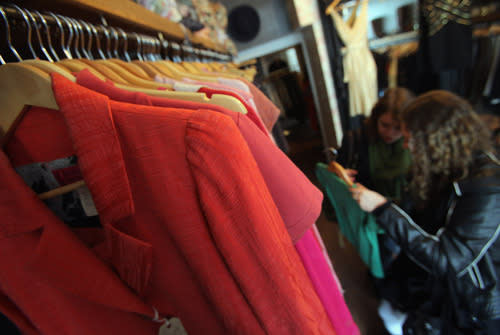
The Smell
It’s unavoidable, buy vintage and your going to get ‘the vintage smell’ this doesn’t mean its dirty it just means its been sitting around for a long time and needs some TLC, just leave it out to air and it will go. Avoid spraying it with anything in case it leaves a stain.
No More Plastic
The number one killer of vintage is leaving them to hang in dry cleaning bags. You might think your protecting it but all your really doing is suffocating the clothes and trapping moisture.
Hang them in plastic and you might return back to them with a nasty moldy and melted surprise.
Washing
ALWAYS hand wash pre-1960s, rather than machine washing and drying it. The fabric wont be able to handle the washing machine and you could end up with a faded and ruined mess.
Avoid washing the clothes as much as possible, as the washing will eventually ruin the fibers (remember that jumper you had that went bobbly). The clothes weren’t designed to be washed regularly so they will tarnish if your not careful. Never ever wash silks, satins or suede’s and leathers!
Fastenings
The fastenings are usually the first thing to break - to pro-long the life of your old metal zipper give it a good lube (nope this isn’t a innuendo) grab some petroleum jelly or even a scribble over it with a graphite pencil to ensure it glides smoothly.
Vintage Shoes
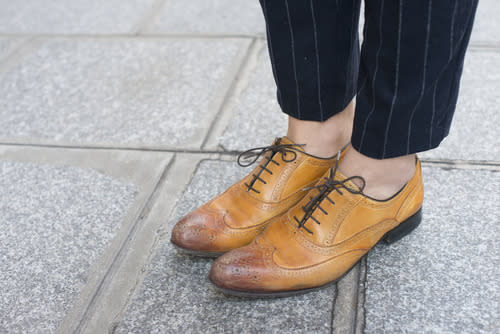
Sizes
Like the old clothes sizes, vintage shoes are also sized different to what todays shoe sizes are. They are usually a touch smaller then what your modern shoe size is especially shoes from the 50s and 60s.
Some also have letters as well as numbers to indicate what size they are;
S, stands for slim.
N, stands for narrow.
B or M, is normal width.
C, is mens.
W, is for wide
Germs
Wearing vintage clothing can be hard enough for some people to deal with, so wearing second-hand shoes can conjure up all sorts of night mares - especially when it comes to germs.
The likelihood that bacteria would even survive in the shoes after been transported and stored in the stores is highly unlikely, but if it is a concern then there are ways to deal with it.
Use rubbing alcohol to kill any remaining bacteria Be careful not to use solution with more than 10% water, because this may damage the shoes. Then place them in direct sun-light for two hours which will dry up the alcohol.
What to look for
The heel tip most likely will be missing, but these are extremely easy to replace and any cobbler will have them. Check all the leather straps, if they look cracked then they’re likely to break, which cannot cheaply be fixed.
Avoid shoes where the leather has stiffened, as they will be extremely uncomfortable to wear and are likely to crumble.
Where To Shop
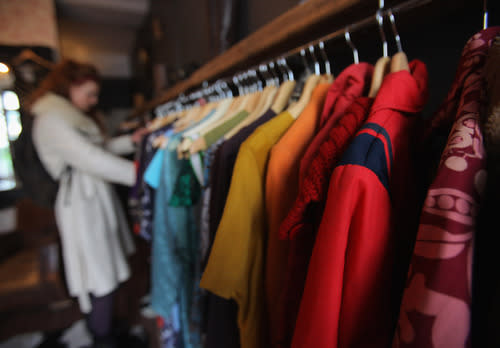
Beyond Retro
Beyond Retro has several stores up and down the country from Brighton to Soho. They specialize in selling 20th-century fashion. There stores are filled to the brim with quirky and outrageous vintage goods. The stores are led by instinctive fashion forecasting and staffed by creative and knowledgeable individuals (including our very own Naomi who handles the online content).
Also Try:
Ebay
Ebay is the great for lazy day shopping trips, brilliant for those who can’t get to the stores to rummage. The only down side is you can’t analyses the garments yourself and have to rely solely on what the listing states, which is always a bit of a gamble.
However there are some reputable business who sell vintage from there eBay stores, try Cosmic Vintage, who specialize in unique and quality garments and accessories.

